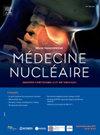Outcomes and radiation safety of Iomab-B (131I-apamistamab) followed by allogeneic hematopoietic cell transplant for patients with relapsed/refractory AML
IF 0.2
4区 医学
Q4 PATHOLOGY
Medecine Nucleaire-Imagerie Fonctionnelle et Metabolique
Pub Date : 2025-02-01
DOI:10.1016/j.mednuc.2024.12.014
引用次数: 0
Abstract
Introduction
Iomab-B (131I-apamistamab), a radioimmunoconjugate to CD45, delivers high-dose targeted radiation to hematopoietic cells for myeloablation and eradication of leukemic cells, enabling patients with active relapsed/refractory acute myeloid leukemia (R/R AML) to proceed to allogeneic hematopoietic cell transplant (HCT). The safety and efficacy of Iomab-B was demonstrated in the SIERRA randomized controlled Phase 3 study.
Methods
Patients (pts) 55 years or older with active R/R AML were randomized (1:1) to Iomab-B or conventional care (CC). Patients on the Iomab-B arm received Iomab-B with fludarabine and total body irradiation (2 Gy) followed by HCT. Pts on the CC arm received physician's choice of salvage therapy and those achieving complete remission (CR) received physician's choice conditioning and HCT, and those that did not could cross over to Iomab-B. Pts received individualized doses of Iomab-B based on organ-specific uptake and dosimetry from gamma camera imaging. Prescribed activity of Iomab-B was determined individually by limiting the estimated absorbed dose to liver to 24 Gy.
Results
153 patients were enrolled, 76 in the Iomab-B arm and 77 in the CC arm. All pts who received the therapeutic dose of Iomab-B (n = 66) underwent HCT vs. 14 (18.2%) on the CC arm, with 44 CC arm patients crossing over to the Iomab-B arm, of whom 40 received the therapeutic dose and HCT. The primary endpoint of durable CR (dCR) at 6 months strongly favored Iomab-B with 22% dCR vs. 0% for CC (p < 0.0001). Iomab-B followed by HCT was well tolerated with lower rates of sepsis for Iomab-B vs. CC (6.1% vs. 28.6%), and respectively 43.9% vs. 50% febrile neutropenia and 15.2% vs. 21.4% mucositis. Based on exposure readings at 1 meter, the median effective clearance half-life of Iomab-B was 35.2 h and median time to reach I-131 release criteria in the United States was 5.0 days (IQR: 3.9–6.1 days). From a subset of 5 clinical sites, average total radiation exposure to staff was 0.09 mSv, with 90% receiving < 0.2 mSv.
Conclusion
Induction and conditioning for relapsed/refractory AML using high-dose Iomab-B targeted radiation was successfully and safely conducted during the phase 3 SIERRA trial, demonstrating significantly improved dCR. With appropriate training and education for clinical sites, and active engagement from nuclear medicine and radiation safety, this novel treatment was delivered with limited exposure to staff and well within regulatory limits.
求助全文
约1分钟内获得全文
求助全文
来源期刊
CiteScore
0.30
自引率
0.00%
发文量
160
审稿时长
19.8 weeks
期刊介绍:
Le but de Médecine nucléaire - Imagerie fonctionnelle et métabolique est de fournir une plate-forme d''échange d''informations cliniques et scientifiques pour la communauté francophone de médecine nucléaire, et de constituer une expérience pédagogique de la rédaction médicale en conformité avec les normes internationales.

 求助内容:
求助内容: 应助结果提醒方式:
应助结果提醒方式:


